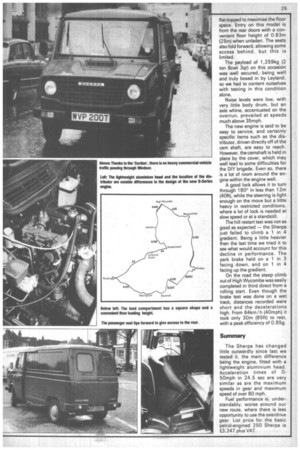Thames Valle3 trip for yam
Page 26

Page 27

If you've noticed an error in this article please click here to report it so we can fix it.
By Bill Brook pctures by Brian WeatherIE
FOR SOME TIME at CM we have talked of improving our light van test route. Our most serious criticism of the old route was its length. It was just too short, so that a small delay, due to a build-up in traffic, could have a disproportionate influence, both on average speeds and fuel consumption results. Now that the new Technical Editor has settled in, we have decided to implement some changes.
My brief was to determine the length of the route, the type of roads it should cover, the terrain and the time it should take. We wanted a mixture of town and rural travel that would not be seriously affected by major changes in traffic density, so that each test will be comparable with the rest. Journey times had to allow two circuits to be completed in the one day's work, while allowing time for weighing and loading.
The Thames Valley, some 30 miles west of London, provides most of the required elements. Within a 15-mile diameter a route can be mapped to include eight towns. The roads. linking them vary from major A-roads to minor B-roads.
The Sherpa van, because of its overdrive, was last tested by us over the Midland route. Now fitted with the 0-Series overhead camshaft petrol engine, it was the vehicle we used to check out the new route.
The starting point is a service station at Littlewick Green, just west at Maidenhead beside the A4. The route takes us from there into the Berkshire county town or Reading and out again, doubling back along the A329, to the hill town of Wokingham, then on to the new town of Bracknell.
Leaving the A-road here, we cut across country on the B3017 and 83022, avoiding the race course at AsEbt, until we arrive at the Royal town of Windsor, in the heart of the infamous cordon.
We cross the river and continue along the Windsor relief road, the A355, passing through the Slough Industrial Estate. Beaconsfield comes next on the old A40, which we follow to High Wycombe, renowned for its furniture industry — and steep hills to the north and south.
Going south, we climb out of the town on the A404, again crossing the M40 before descending into the Thames Valley to pass through Marlow. A good climb once more over the hills „on the A308 brings us to Maidenhead and back to the A4 and the point from which we started — a total distance of 96,2km (59.8 miles), In the Sherpa we completed the journey in just over two hours at an average speed of 47.6km/h (29.6mph), Consuming only 11.59 litres (2,55gal) the vehicle returned 12.071it/ 100km (23.4mpg), This is both slower and thirstier than on the previous Sherpa test.
The 1,700cc engine, rated at 45kW (61 bhp) with a maximum torque of 100Nm (811 bft) pulled well in direct top and over-drive could be often Used, but even small inclines made a changedown necessary.
The driving position is comfortable, but access is restricted by the driving seat itself. Visibility to the front, sides, and rear is adequate. The interior mirror was of less use than the good-sized exterior mirrors mounted on sturdy arms.
The load area of 5.38cum (192cuft) presents a square uncluttered box. Only the wheel arches intrude, but these are
flat-topped to maximise the floor space. Entry on this model is from the rear doors with a convenient floor height of 0.63m -(25in) when unladen. The seats also fold forward, allowing some access behind, but this is limited.
The payload of 1,259kg (2 ton 8cwt 3qr) on this occasion was well secured, • being well and truly boxed in by Leyland, so we had to content outselves with testing in this condition alone.
Noise levels were low, with very little body drum, but an axle whine, accentuated on the overrun, prevailed at speeds much above 35mph.
The new engine is said to be easy to service, and certainly specific items such as the distributor, driven directly off of the cam shaft, are easy to reach. However, the camshaft is held in place by the cover, which may well lead to some difficulties for the DIY brigade. Even so, there is a lot of room around the engine within the engine well.
A good lock allows it to turn through 180° in less than 12m (40ft), while the steering is light enough on the move but a little heavy in restricted conditions, where a lot of lock is needed at slow speed or at a standstill.
The hill restart test was not as good as expected — the Sherpa just failed to climb a 1 in 4 gradient. Being a little heavier than the last time we tried it to see what would account for this decline in performance. The park brake held on a 1 in 3 facing down, and on 1 in 4 facing up the gradient.
On the road the steep climb out of High Wycombe was easily completed in third direct from a rolling start. Even though the brake test was done on a wet track, distances recorded were short and the decelerations high. From 64km / h (40mph) it took only 30m (85ft) to rest, with a peak efficiency of 0.85g.
Summary
The Sherpa has changed little outwardly since last we tested it, the main difference being the engine, fitted with a lightweight aluminium head. Acceleration times of 050mph in 24.5 sec are very similar as are the maximum speeds in gear and maximum speed of over 80 mph.
Fuel performance is, understandably, worse around our new route, where there is less opportunity to use the overdrive gear. List price for the basic petrol-engined 250 Sherpa is £3,247 plus VAT.
























































































